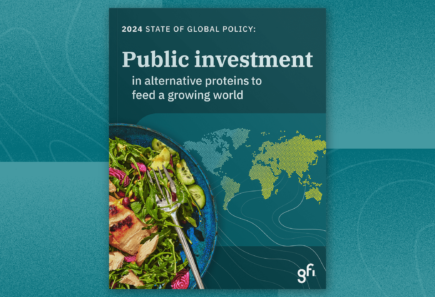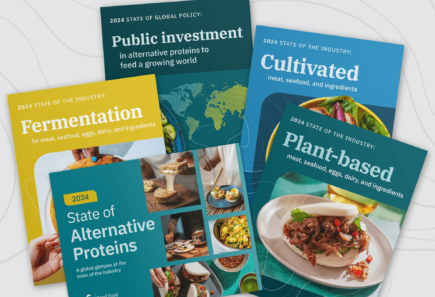
Alternative protein innovation bolsters national security
Alternative protein technologies produce meat with remarkable efficiency, providing an excellent fortification for our food system and defense against growing global threats. In the interest of national security, the United States should invest in alternative protein innovation.
Save this document
The role of alternative proteins in national security
Civilian security, global stability, and military readiness depend on a robust and secure food system. Alternative protein technologies are crucial to strengthening our national security, from promoting supply chain resilience to supporting U.S. defense capabilities.
Investing in alternative proteins can advance national security by:
- Promoting supply chain resilience, as production processes require fewer inputs and supply chain links.
- Reducing our vulnerability to zoonotic disease outbreaks such as avian or swine flu.
- Mitigating agricultural bioterrorism in our food supply.1
- Supporting a U.S. export market that meets growing global food demand and mitigates future food-related conflict.
- Enabling point-of-need food manufacturing for U.S. defense forces in deployed settings.
Bolstering supply chain resilience and agility
According to the Center for Strategic and International Studies (CSIS), alternative proteins are less vulnerable to supply disruptions due to their simplified and localized production processes.2
Producing plant-based, fermentation-derived, and cultivated meat requires fewer inputs—including land, water, and crops—and supply chain links.3 For example, plant-based meat requires up to 98 percent less land than conventional meat.4
In addition, alternative protein production facilities are adaptable to versatile locations and can be placed close to existing supply chains. Alternative protein production at scale can, therefore, improve the U.S. food system’s resistance to shocks and disruptions.
Alternative protein technologies explained
Fermentation
Fermentation is a powerful, flexible process using microorganisms to produce food. Biomass fermentation efficiently produces large amounts of protein-rich food, while precision fermentation produces specific proteins, fats, flavor molecules, and vitamins. These technologies, which have long been employed in the medical field, can create food in low-resource areas, including on military bases, at sea, or in space.
Plant-based
Plant-based food manufacturing produces food from crops and plant ingredients. Plant-based food production is resource-efficient and adaptable, directly converting plants into meat, dairy, and other products.
Cultivated meat
Cultivated meat produces food directly from animal cells. Meat and seafood cultivation uses inputs like those that build muscle and fat in livestock—and is deployable in diverse settings, including austere conditions.
Promoting biosecurity in our food supply and global security
The U.S. supply chain for conventional meat is highly centralized, making it susceptible to potential attack or disruption—as demonstrated during the COVID-19 pandemic.5 According to CSIS, alternative protein production mitigates risks of potential agricultural bioterrorism.
These technologies can insulate the country from attacks targeting agricultural production infrastructure and the introduction of animal diseases that could quickly compromise significant portions of our protein supply.6 Fermentation-derived, plant-based, and cultivated meat are protected from animal disease outbreaks, as they do not rely on livestock. An expanded alternative protein sector also promotes food security through supply chain diversification. Rising food demand is expected to coincide with declines in global crop yields.7 Expanding U.S. protein production can mitigate future food-related conflicts and humanitarian crises, allowing us to address rising food demand as the planet nears 10 billion people by 2050. As a high-value export industry, U.S. alternative protein companies will also help rebuild a U.S. trade surplus after years of agricultural trade deficits.8
“The ability of the U.S. military to project power entails an equally imposing logistical chain to maintain stocks of food, water, medicines, fuel, and other supplies…DoD is actively investigating ways critical supplies are procured in addition to creating systems that can rapidly produce materials, including food onsite, when and where they are needed.”
-The U.S. Pentagon11
Enabling point-of-need food production at military bases
Maintaining the readiness of military personnel and operational continuity depends on secure food supplies. With simplified production processes—requiring less land and other resources—alternative protein technologies enable point-of-need food production at military bases, at sea, or in space, in addition to producing healthy, nutritious ingredients for Meals Ready to Eat (MRE).9
Point-of-need production reduces logistical costs and saves lives. For example, between 2005 and 2011 the Department of Defense (DoD) spent $5.5 billion to deliver food to U.S. military sites in Afghanistan, and more than 300 truck drivers and security guards were killed in the process.10 For these reasons, DoD has invested in alternative protein innovation. According to the Pentagon: “The ability of the U.S. military to project power entails an equally imposing logistical chain to maintain stocks of food, water, medicines, fuel, and other supplies…DoD is actively investigating ways critical supplies are procured in addition to creating systems that can rapidly produce materials, including food onsite, when and where they are needed.”11
American competitiveness
While American researchers have been at the forefront of alternative protein innovation, the United States faces steep competition from several countries. China has made alternative proteins a governmental priority, in line with a broader commitment to agricultural biotechnology—a sector which China is now positioned to lead, according to the U.S. Director of National Intelligence.12
While the U.S. private sector has led the way in alternative protein innovation, on the public sector side, the United States has invested only $128 million to date. In contrast, governments worldwide invested $523 million in 2023, for an all-time investment total of $1.67 billion.13 To maintain global leadership, the United States must increase public investments. Research, development, and commercialization of food technologies will also grow the economy. Globally, the alternative protein industry can support up to 9.8 million jobs and generate $1.1 trillion in economic value.14 With proper investment, the United States will lead in job creation and economic growth.
Investing in alternative proteins is vital for national security
Alternative protein R&D and commercialization should be a top national priority. Sufficient public investment will fortify our food system, drive American innovation, and expand defense capabilities. By harnessing the power of alternative protein technologies, the United States can build a resilient food system and promote national security for future generations.
References
1-3. Swanson, Zane, Caitlin Welsh, and Joseph Majkut. 2023. “Mitigating Risk and Capturing Opportunity: The Future of Alternative Proteins.” Center for Strategic and International Studies (CSIS), Washington, DC. https://csis-website-prod.s3.amazonaws.com/s3fs-public/2023-05/230511_Swanson_Alternative_Proteins.pdf?VersionId=Za76gtRSXe0eahjwFvr5hw54uHzCXuT5.
4. GFI. 2023. “Environmental Impacts of Alternative Proteins.” https://gfi.org/resource/environmental-impacts.
5. Brown, Bradford, Paul Garvey, Megan Smith, Eric Harley, Monica Mendoza, and Jeff Harrold. 2021. “U.S. Food Supply Chain Security: A Network Analysis.” MITRE. https://www.mitre.org/news-insights/publication/us-food-supply-chain-security-network-analysis.
6. Swanson, et al. (see reference 1).
7. Zhao, Chuang, Bing Liu, Shilong Piao, Xuhui Wang, David B. Lobell, Yao Huang, Mengtian Huang, et al. 2017. “Temperature Increase Reduces Global Yields of Major Crops in Four Independent Estimates.” PNAS 114 (35): 9326-9331. https://doi.org/10.1073/pnas.1701762114.
8. Kenner, Bart, Hui Jiang, Dylan Russell, and James Kaufman. 2023. “Outlook for U.S. Agricultural Trade: August 2023.” USDA, Economic Research Service, and Foreign Agricultural Service: Report No. AES-125. https://www.ers.usda.gov/webdocs/outlooks/107311/aes-125.pdf?v=1152.5.
9. Defense Advanced Research Projects Agency (DARPA). n.d. “Cornucopia.” https://www.darpa.mil/program/cornucopia; Nature’s Fynd. 2022. “Nature’s Fynd Collaborates with NASA.” https://www.naturesfynd.com/press-release/collaboration-with-nasa-to-grow-fy-protein-in-space; Bryant, Christopher J. 2022. “Plant-Based Animal Product Alternatives Are Healthier and More Environmentally Sustainable Than Animal Products.” Future Foods Vol. 6 (December): 100174. https://doi.org/10.1016/j.fufo.2022.100174.
10. U.S. Government Publishing Office. 2013. “Contracting to Feed U.S. Troops In Afghanistan” (House Hearing, 113 Congress). https://www.govinfo.gov/content/pkg/CHRG-113hhrg81829/html/CHRG-113hhrg81829.htm.
11. Fraser, Phoebe. 2024. “US Department of Defense to Fund Alt-Protein Projects.” Cell Base. https://www.thecellbase.com/news/us-department-of-defense-to-fund-alt-protein-projects.
12. GFI. 2024. “The State of Global Policy on Alternative Proteins.” https://gfi.org/globalpolicy; Director of National Intelligence. 2024. “Annual Threat Assessment of the U.S. Intelligence Community.” Page 9. https://www.dni.gov/files/ODNI/documents/assessments/ATA-2024-Unclassified-Report.pdf.
13. GFI (see reference 12).14. ClimateWorks Foundation and the UK Foreign, Commonwealth & Development Office. 2021. “Global Innovation Needs Assessments: Protein Diversity.” https://www.climateworks.org/wp-content/uploads/2021/11/GINAs-Protein-Diversity.pdf.





